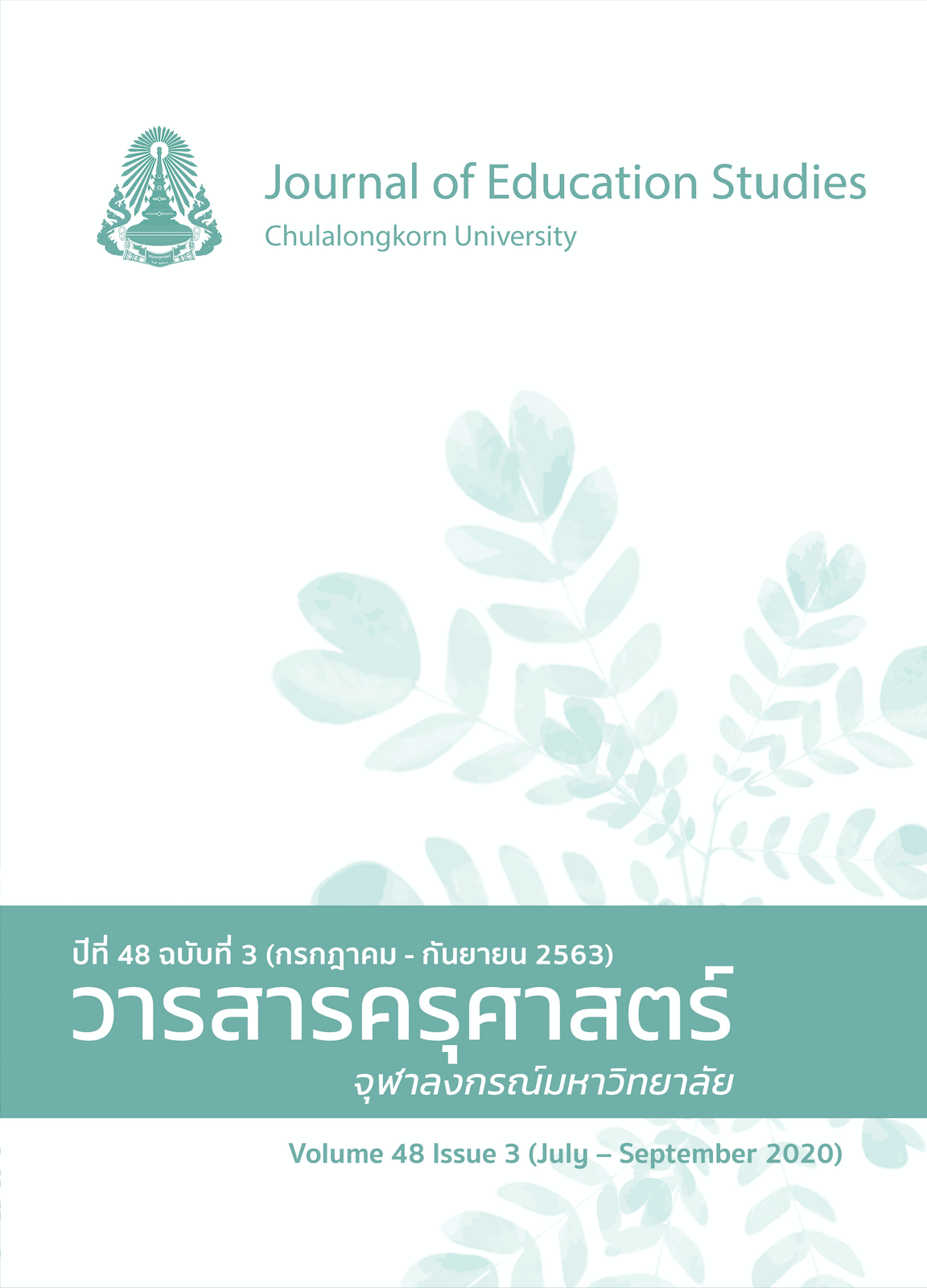Effects of the Circuit Training Activity Set Development Promoting Physical Fitness for Physical Education Activity Course Students
Keywords:
health-related physical fitness, physical activity, health promotion, university studentsAbstract
The purposes of this study were 1) to develop a circuit training activity set promoting physical fitness and 2) to examine the efficacy of the mentioned activity set promoting physical fitness for 25 Chulalongkorn University students. They were divided into 2 groups including, a control group and an experimental group. The control group received the normal lesson plan. The experimental group received developed activities of the physical fitness promotion for the duration of 8 weeks. Their scores of the 5 health-related physical fitness components test were compared before and after the experiment. The researcher developed the circuit training activity set for physical fitness promotion and utilized the health-related physical fitness test. The data were analyzed by using mean, standard deviation, and t-test.
The study found that 1) The Index of Item-Objective Congruence of the circuit training activity set promoting physical fitness consisting of flexibility enhancing activities, muscular strengthening activities, muscular endurance strengthening activities and the cardiovascular endurance promoting activities was 1.00. 2) the mean scores of the physical fitness of the experimental group consisting of sit-ups for 60 seconds, push-ups for 30 seconds, sit and reach and distance running after studying exercises were significantly higher than before studying at a .05 level of significance, except for the body mass index.; and 3) the mean scores of the physical fitness of the experimental group after studying exercises in all items, except for the body mass index were significantly higher than that of the control group at a .05 level.
References
เกรียงไกร อินทรชัย. (2559). ประมวลรายวิชากิจกรรมพลศึกษาสำหรับครู (แบดมินตัน). เอกสารไม่ได้ตีพิมพ์, คณะครุศาสตร์, จุฬาลงกรณ์มหาวิทยาลัย, กรุงเทพฯ, ประเทศไทย
โครงการสุขภาพคนไทย. (2559). ทำความรู้จักคนต่างรุ่นต่าง “เจเนอเรชัน”. ในคณะทำงานสุขภาพคนไทย (บ.ก.), สุขภาพคนไทย 2559: ตายดี วิถีที่เลือกได้ (น. 8-9). นครปฐม: สถาบันวิจัยประชากรและสังคม มหาวิทยาลัยมหิดล.
ธรรมชาติ นาคะพันธ์. (2557). ผลของโปรแกรมการฝึกแบบสถานีที่มีต่อความสามารถในการเลี้ยงลูกฟุตซอลของนักเรียนระดับชั้นมัธยมศึกษาตอนปลาย. (วิทยานิพนธ์ปริญญามหาบัณฑิต ไม่ได้ตีพิมพ์). จุฬาลงกรณ์มหาวิทยาลัย, ประเทศไทย.
วสุนธรา รตโนภาส และสุนารี แซ่ว่าง. (2558). พฤติกรรมการควบคุมน้ำหนัก : กรณีศึกษานักศึกษาโปรแกรมวิชาสาธารณสุขศาสตร์ มหาวิทยาลัยราชภัฏกำแพงเพชร. รายงานสืบเนื่องการประชุมวิชาการระดับชาติ สถาบันวิจัยและพัฒนา มหาวิทยาลัยราชภัฏกำแพงเพชร ครั้งที่ 2 (579-585). กำแพงเพชร: มหาวิทยาลัยราชภัฏกำแพงเพชร.
สำนักงานกองทุนสนับสนุนการสร้างเสริมสุขภาพ. (2549). แบบทดสอบและเกณฑ์มาตรฐานสมรรถภาพทางกายที่สัมพันธ์กับสุขภาพสำหรับเด็กไทย อายุ 7-18 ปี. ม.ป.พ.
ภาษาอังกฤษ
Aekplakorn, W., Chaiyapong, Y., Neal, B., Chariyalertsak, S., Kunanusont, C., Phoolcharoen, W., et al. (2004). Prevalence and determinants of overweight and obesity in Thai adult. Journal of the Medical Association of Thailand, 87(6), 685-693.
Ahn, S., & Fedewa, A. L. (2011). A meta-analysis of the relationship between children’s physical activity and mental health. Journal of Pediatric Psychology Advance, 36(4), 385-397.
Bailey, R. (2006). Physical education and sport in schools: A review of benefits and outcomes. Journal of School Health, 76(8), 397-401.
Biddle, S. (1999). The motivation of pupils in physical education. In C.A. Hardy and M. Mawer (Eds.), Learning and teaching in physical education. London: Falmer Routledge.
Boujut, E., & Bruchon-Schweitzer, M. (2009). A construction and validation of a freshman stress questionnaire: An exploratory study. Journal of Psychological Report, 104(2), 680–692.
Bragg, M., Tucker, C., Kaye, L., & Desmond, F. (2009). Motivators of and barriers to engaging in physical activity: Perspective of low-income culturally diverse adolescents and adults. American Journal of Health Education, 40, 146-154.
Budde, H., Voelcker-Rehage, C., Pietraßyk-Kendziorra, S., Ribeiro, P., & Tidow, G. (2008). Acute coordinative exercise improves attentional performance in adolescents. Neuroscience Letters, 441(2), 219–223.
Eather, N., Morgan, P. J., & Lubans, D. R. (2013). Improving the fitness and physical activity level of primary school children: Result of fit-4-fun group randomized controlled trial. Journal of Preventive Medicine, 56, 12-19.
Fernhall, B., Borghi-Silva, A., & Babu, A. S. (2015). The future of physical activity research: Funding, opportunities and challenge. Progress in Cardiovascular Deceases, 57(4), 299-305.
Finlayson, G., Cecil, J., Higgs, S., Hill, A., & Hetherington, M. (2012). Susceptibility to weight gain. Eating behavior traits and physical activity as predictors of weight gain during the first year of university. Appetite, 58(3), 1091–1098.
Fisher, A., Reilly, J. J., Kelly, L. A., Montgomery, C., Williamson, A., Paton, J. Y., & Grant, S. (2005). Fundamental movement skill and habitual physical activity in young children. Medicine and Science in Sports and Exercise, 37(4), 684–688.
Hills, A. P., Dengel, D. R., & Lubans, D. R. (2015). Supporting public health priorities: Recommendations for physical education and physical activity promotion in schools. Progress in cardiovascular diseases, 57(4), 368-374.
Kim, H., Lee, J., & So, Y. (2018). The relationship of exercise frequency to body composition and physical fitness in dormitory-dwelling university students. Journal of Mens Health, 14(1), 332-343.
National Association for Sport and Physical Education, an Association of the American Alliance for Health, Physical Education, Recreation and Dance. (2011). Physical education for lifelong fitness: The physical best teacher’s guide. Champaign, IL: Human Kinetics.
Ortega, B., Ruiz, J., Castillo, J., & Sjostrom, M. (2008). Pediatric review: Physical fitness in childhood and adolescence: A powerful marker of health. International Journal of Obesity, 32, 1-11.
World Health Organization. (2006). Workshop on the implementing the Global strategy on Diet, Physical Activity and Health in Asian countries. WHO Western Pacific Region.
World Health Organization. (2010). Workshop on the implementing the global strategy on diet, physical activity and health in Asian countries. WHO Western Pacific Region.




